3 OPHTHALMOLOGIC LABORATORY AND DIAGNOSTIC TESTS
Selected Laboratory Tests in Ocular Disease
Laurance Freier
 SELECTED LABORATORY TESTS IN OCULAR DISEASE
SELECTED LABORATORY TESTS IN OCULAR DISEASE
This section lists suggested laboratory and diagnostic tests for ocular disorders and systemic diseases that may have ophthalmic manifestations. These lists are not meant to be exhaustive, nor should every test listed be done in every case. In general, diagnostic tests are ordered only when their results will have a direct bearing on the management of the patient.
For the abbreviations of tests used in the lists, see Chapter 2, “Common Laboratory Tests and Procedures.” Asterisks (*) indicate a nonspecific, initial group of tests. If the patient’s history, signs, or symptoms suggest a particular etiology, additional tests should be done as indicated. See tests listed under individual etiologies. For systemic diseases associated with anterior uveitis, see Table 3-1.
TABLE 3-1 Systemic Diseases Associated with Anterior Uveitis
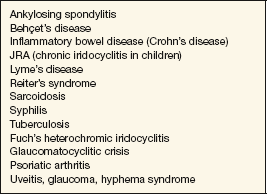
Acanthamoeba
- Gram stain
- Giemsa stain (to help distinguish from herpes simplex)
- Calcofluor white stain
- Culture: Nonnutrient agar with Escherichia coli overlay
- Confocal microscopy
- Corneal biopsy (if stains and cultures are all negative and condition does not improve) (Figs. 3-1 and 3-2)

Figure 3-1. Acanthamoeba cornea.
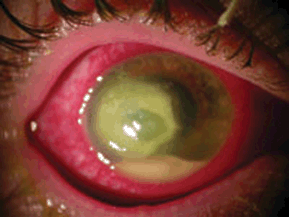
Figure 3-2. Acanthamoeba keratitis.
Acute Retinal Necrosis
- Complete blood count (CBC) with differential
- Erythrocyte sedimentation rate (ESR)
- Rapid plasma reagin (RPR) and fluorescent treponemal antibody-absorption (FTA-ABS)
- Chest x-ray
- Purified protein derivative (PPD) with anergy panel
- Computed tomography (CT) scan of the orbit or B-scan ultrasound (to check for an enlarged optic nerve)
- Consider a fluorescein angiogram
- Consider urine studies for cytomegalovirus (especially if patient is immunocompromised)
- Consider toxoplasmosis enzyme-linked immunosorbent assay (ELISA) and serum titers for herpes simplex and varicella zoster
- Human immunodeficiency virus (HIV) test if patient is from a high-risk group for acquired immunodeficiency syndrome (AIDS) (Fig. 3-3)

Figure 3-3. Acute retinal necrosis.
- Immediate ESR, Westergren method (if giant cell arteritis [GCA] is suspected)
- Fasting blood sugar (FBS) and glucose tolerance test (GTT) (to rule out diabetes)
- CBC with differential and platelet count (to rule out polycythemia and thrombocytosis)
- Lipid profile (to rule out hyperlipidemia)
- Serum cholesterol
- Hemoglobin, Hct
- Carotid artery evaluation (duplex scan-Doppler and ultrasound)
- Two-dimensional echocardiogram
- Holter monitor
- ECG
- Digital subtraction angiogram
- CT scan or magnetic resonance imaging (MRI)
- Carotid arteriogram (only if carotid surgery is planned)
- Consider a fluorescein angiogram (may show focal staining at the site of the embolus)
Angioid Streaks
- Skin biopsy (if pseudoxanthoma elasticum is suspected)
- Cardiovascular exam to rule out aortic aneurysm
- Skull x-ray to rule out Paget’s disease
- Serum alkaline phosphatase and urine calcium level if Paget’s disease is suspected
- Sickle cell prep and hemoglobin electrophoresis (to rule out homozygous sickle cell disease) if patient is black or has Mediterranean background
- PO4 levels (to rule out hyperphosphatemia)
- Fluorescein angiogram to check for neovascular membrane (Fig. 3-4A,B)


Figure 3-4. A: Angioid streaks (arrows). B: pseudoxanthoma elasticum.
Aniridia
- Consider renal ultrasound (if Wilms tumor is suspected)
- Consider intravenous pyelography (if ultrasound suggests possibility of Wilms tumor)
- Consider chromosomal karyotype (deletion of the short arm of chromosome II suggests an increased chance of a Wilms tumor)
Anisocoria (Pharmacologic Tests)
- Greater in light or dark (nonbenign)
- Light (abnormal large pupil-parasympathetic lesion)
1. Weak pilocarpine test (1/16% to 0.0625%): Adies tonic pupil
2. Strong pilocarpine test (1%): Pharmacologic versus neurologic pupil
- Dark (abnormal small pupil-sympathetic lesion)
1. Aproclonidine 1%: Differentiate second versus third neuron lesion (Fig. 3-5)

Figure 3-5. Aniscoria.
Ankylosing Spondylitis
- Men: x-ray of sacroiliac joints; CT scan
- Women: x-ray of shoulders
- ESR
- HLA-B27
Anterior Uveitis; Iritis/Iridocyclitis*
- Antinuclear antibody (ANA)
- CBC
- ESR
- RPR or Venereal Disease Research Laboratory (VDRL) and FTA-ABS
- Chest x-ray (to rule out sarcoidosis and tuberculosis)
- PPD and anergy panel
- In endemic areas, lab tests for Lyme’s disease
Arcus Senilis (in a Patient <50 Years Old)
- Serum cholesterol
- Lipoprotein electrophoresis
- Serum triglycerides (to rule out type II or V hyperlipoproteinemia)
- FBS (to rule out adult onset diabetes mellitus) (Fig. 3-6)
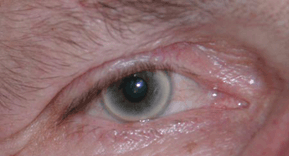
Figure 3-6. Arcus senilis.
Argyll Robertson Pupil
- RPR or VDRL
- FTA-ABS or microhemagglutination assay for triponema pallidium (MHA-TP)
- Consider a lumbar puncture (if diagnosis of syphilis is established)
- Albumin
- Blood urea nitrogen (BUN)
- Creatinine
- Magnesium
- Phosphorus level
- Serum calcium
- Uric acid level (if gout is suspected)
- ANA, ESR, rheumatoid factor (RF), x-rays of the knees (if juvenile rheumatoid arthritis [JRA] is suspected)
- Other tests directed toward a specific, suspected etiology (e.g., sarcoidosis)
Behçet’s Disease
- Behçet’s skin puncture test
- HLA-B27 or HLA-B5
- Medicine or rheumatology consult (Fig. 3-7)
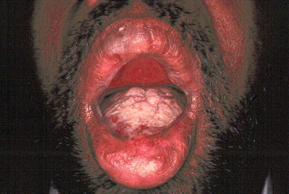
Figure 3-7. Behçet’s disease.
Blind Infant
- Electro-retinagram (ERG)
- Visual-evoked potential (VEP)
- Consider a CT scan and/or MRI of the brain
Blow-Out Fracture of the Orbit
- CT scan (axial and coronal views) of the orbits and brain if surgery is planned or if the diagnosis is uncertain
Branch Retinal Artery Occlusion
- Carotid artery evaluation (Doppler and ultrasound)
- FBS (3-hour GTT if findings are negative)
- Immediate ESR, Westergren method (to rule out GCA if patient is ≥55 years old)
- Greater superficial temporal artery biopsy if GCA is suspected because of symptoms or ESR findings
- Echocardiogram
- Holter monitor
- Blood tests: ANA, CBC with differential and platelets, FTA-ABS, lipid profile, prothrombin time (PT) or partial thromboplastin time (PTT), and RF
- Hct and hemoglobin electrophoresis
- Serum protein electrophoresis (Fig. 3-8)

Figure 3-8. Branch retinal artery occlusion.
Branch Retinal Vein Occlusion (BRVO)
- FBS
- CBC with differential and platelets
- ANA
- ESR
- PT or PTT
- RF
- Fluorescein angiogram
- Chest x-ray
- Internal medicine consult (to check for cardiovascular disease) (Fig. 3-9)
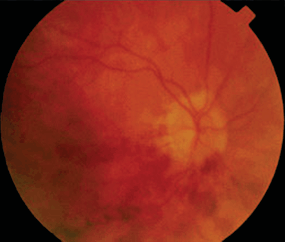
Figure 3-9. Branch retinal vein occlusion.
Canaliculitis
- Cultures of material expressed from the punctum
- Blood agar
- Chocolate agar
- Sabouraud’s medium
- Thioglycolate broth
- Gram stain
- Giemsa stain
- Thioglycolate broth
Candidiasis
- BUN
- CBC
- Creatinine
- Liver function tests (see list under “Postoperative Endophthalmitis”)
- Blood and urine cultures for Candida
- Vitreous cultures (when there is a significant amount of vitreous involvement) can be used to confirm a diagnosis and to test sensitivity to antifungal agents
- Consider HIV tests
Cavernous Sinus Syndrome: Multiple Ocular Motor Palsies
- CT scan (axial and coronal views) or MRI of the brain, orbit, and sinuses
- If the CT scan and MRI are normal, consider the following:
1. ANA, CBC with differential, ESR, and RF (to rule out infection, malignancy, or a systemic vasculitis)
2. A blind nasopharyngeal biopsy (to rule out a nasopharyngeal carcinoma)
3. Chest x-ray
4. Lumbar puncture (three times; to rule out carcinomatous meningitis)
5. Lymph node biopsy (if a lymphadenopathy is present)
6. A repeat CT scan or MRI if the cavernous sinus was not well visualized
7. A cerebral arteriogram to rule out an aneurysm or arteriovenous fistula (but these are usually seen on the CT scan)
- Blood cultures (three times) plus a culture of the presumed primary source of infection if a cavernous thrombosis is suspected
Central Retinal Artery Occlusion
- Immediate ESR, Westergren method (to rule out GCA if patient is ≥55 years old)
- Greater superficial temporal artery biopsy if GCA is suspected because of symptoms or ESR findings
- Carotid artery evaluation (Doppler and ultrasound)
- FBS (3-hour GTT if findings are negative)
- Echocardiogram
- Holter monitor
- Blood tests: ANA, CBC with differential and platelets, lipid profile, FTA-ABS, PT or PTT, and RF
- Hct and hemoglobin electrophoresis
- Serum protein electrophoresis
- Consider ERG or fluorescein angiogram to help confirm diagnosis
Central Retinal Vein Occlusion (CRVO)
- CBC with differential and platelets
- FBS
- Lipid profile
- VDRL and FTA-ABS
- Serum protein electrophoresis
- ANA
- Cryoglobulins
- ESR
- Hemoglobin electrophoresis
- PT or PTT
- Fluorescein angiogram (to rule out diabetic retinopathy)
- Ophthalmodynamometry or oculopneumoplethysmography (to help distinguish a CRVO from carotid artery disease; ophthalmic artery pressure is usually normal or elevated in a CRVO but is usually low in carotid disease)
- Chest x-ray (to rule out an underlying medical problem)
- Ophthalmodynamometry or oculopneumoplethysmography (to help distinguish a CRVO from carotid artery disease; ophthalmic artery pressure is usually normal or elevated in a CRVO but is usually low in carotid disease)
Chlamydial Inclusion Conjunctivitis
- Giemsa stain of conjunctival scraping (will show inclusion bodies within epithelial cells, lymphocytes, and polymorphonuclear leukocytes)
- Chlamydial immunofluorescence test
- Detection of Chlamydia antigen (enzyme immunoassay [EIA], direct fluorescent antibody [DFA]) or DNA (Fig. 3-10)
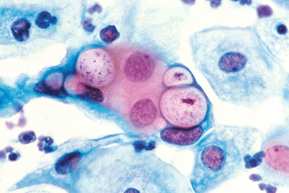
Figure 3-10. Chlamydial inclusion conjunctivitis.
Choroidal Detachment
- B-scan ultrasonography if melanoma is suspected
Congenital Cataract
- B-scan ultrasound if fundus view is obscured
- Red blood cell (RBC) galactokinase activity and RBC galactose-l-phosphate-uridyltransferase activity (to rule out galactosemia)
- Serum calcium (to rule out hypocalcemia or hypoparathyroidism)
- Serum glucose (to check for diabetes mellitus and hypoglycemia)
- Urine copper level (to check for Wilson’s disease)
- Urine amino acid content (to check for Lowe’s syndrome)
- Urine protein and blood quantitation (to check for Alport’s syndrome)
- Urine sodium nitroprusside test (to rule out homocystinuria)
- Rubella antibody detection test
Conjunctival Laceration
- B-scan ultrasound
- CT scan of the orbit (axial and coronal views) to rule out an intraorbital or intraocular foreign body or a ruptured globe
Hyperacute Conjunctivitis
- Gram stain
- Cultures:
1. Blood agar (supports growth of most bacteria)
2. Chocolate agar (enhances isolation of Haemophilus, Moraxella, and Neisseria)
3. Thayer-Martin plate (isolates Neisseria)
- Antibiotic sensitivity testing (Fig. 3-11)
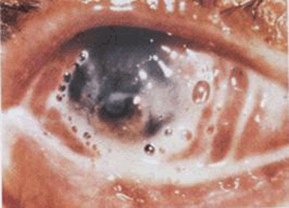
Figure 3-11. Hyperacute conjunctivitis.
Cornea: Central Crystalline Dystrophy
- Fasting serum cholesterol
- Serum triglycerides (to check for hypercholesterolemia and hyperlipidemia) (Fig. 3-12)
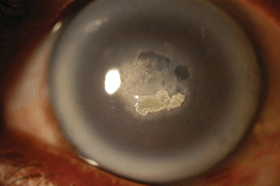
Figure 3-12. Crystalline dystrophy.
- CBC with differential, ESR, RF, and ANA (to rule out collagen vascular disease)
- Cultures (if infection is suspected):
1. Blood agar
2. Chocolate agar
3. Sabouraud’s agar
4. Thioglycolate agar
5. Gram stain
6. Giemsa stain
- If a scleritis is present:
1. RPR and PTA-ABS
2. Uric acid
3. FBS
4. Serum protein electrophoresis and circulating immune complexes (if connective tissue disease is suspected)
5. C-reactive protein
6. B-scan ultrasound (to detect posterior scleritis)
7. CT scan or MRI, if indicated
8. Chest x-ray
9. PPD with anergy panel
10. X-rays of joints
11. X-ray of sacroiliac joints
- Internal medicine consult if collagen vascular disease or leukemia is suspected
Infectious Corneal Ulcers
- Smears and cultures:
1. Blood agar
2. Chocolate agar
3. Sabouraud’s medium
4. Thioglycolate broth
5. Gram stain
6. Giemsa stain
- Other stains:
1. Methenamine silver (if fungal infection)
2. Potassium hydroxide preparation and periodic acid-Schiff (PAS) stains (useful in identifying fungi)
3. Papanicolaou stain (to rule out intranuclear inclusions)
4. Acid-fast (when Mycobacterium or Nocardia is suspected)
5. Calcofluor white (when Acanthamoeba is suspected)
- Other media:
1. Lowenstein-Jensen agar (if Mycobacterium or Nocardia are suspected)
2. Thayer-Martin agar (to isolate Neisseria)
3. Brain-heart infusion broth (useful in patients with fastidious bacteria or fungi, or those already on antibiotics)
4. Nonnutrient agar with E. coli overlay (if Acanthamoeba is suspected)
Cortical Blindness
- CT or MRI scan of the brain
- CBC (to rule out polycythemia)
- Neurologic consult to evaluate risk of stroke
Cranial Arteritis (See Headache)
Cystoid Macular Edema
- Fluorescein angiography (may show classic “flower petal” pattern)
- When indicated:
1. FBS
2. GTT
3. CRVO lab tests
4. BRVO lab tests
5. ERG (retinitis pigmentosa [RP]); other lab tests indicated by suspected etiology
Cytomegalovirus (CMV) Retinopathy
- Urine studies for CMV
- ESR
- Consider fluorescein angiography
- Complement fixation test
- Internal medicine consult
- Consider HIV tests (Fig. 3-13)

Figure 3-13. Cytomegalovirus retinopathy.
Dacryoadenitis
Acute Infectious
- Cultures of any discharge:
1. Blood agar
2. Chocolate agar
3. Sabouraud’s medium
4. Thioglycolate broth
5. Gram stain
- CBC with differential (if patient is febrile)
- CT scan (axial and coronal views) of the orbit and brain (if a mass is suspected, if there is a motility restriction, or if there is a proptosis)
Chronic
- CBC with differential
- ESR
- ACE
- PPD with anergy panel
- Chest x-ray (to help detect sarcoidosis or TB)
- RPR or VDRL and FTA-ABS
- CT scan (axial and coronal views) of the orbit
- Lacrimal gland biopsy (if a malignant tumor is suspected or if the diagnosis is uncertain)
- If a lymphoma is suspected:
1. Bone marrow biopsy
2. CT scan of the abdomen
3. CT scan of the brain
4. Serum protein electrophoresis
5. Internal medicine or oncology consult
- CT scan (axial and coronal views) of the orbit
Dacryocystitis
- Cultures of material expressed from punctum:
1. Blood agar
2. Chocolate agar
3. Sabouraud’s medium
4. Thioglycolate broth
5. Gram stain
- CT scan (axial and coronal views) of the orbit and paranasal sinuses (if condition does not improve, or in atypical cases)
Diabetic Retinopathy
- FBS
- HB A1c
- GTT
- Fluorescein angiogram if neovascularization or macular edema is suspected
- Consider blood tests for hyperlipidemia if much exudate is found (Fig. 3-14)
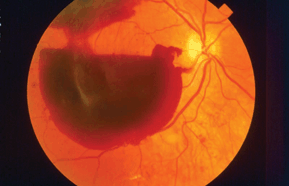
Figure 3-14. Diabetic retinopathy.
Episcleritis
- ANA
- ESR
- RF and CBC with differential (if collagen vascular disease is suspected)
- Serum uric acid (if gout is suspected)
- RPR or VDRL and FTA-ABS (if syphilis is suspected)
Eyelid Laceration
- Consider CT scan (axial and coronal views) of the orbit and brain (to rule out an intraorbital foreign body, or a ruptured globe, or in cases of significant orbital trauma)
Malignant Tumors of the Eyelid
- Incisional biopsy
- Excisional biopsy (preferable for malignant melanoma)
- Internal medicine consult for metastatic workup if sebaceous cell carcinoma is confirmed
- Oil red-O stain of frozen or nonfixed tissue if sebaceous cell carcinoma is suspected (Fig. 3-15)

Figure 3-15. Lid tumor.
Stay updated, free articles. Join our Telegram channel

Full access? Get Clinical Tree


